Cataloger's Reference Shelf
CONSER Cataloging Manual
22.3. Choice of entry and changes in entry
As with AACR2, serials cataloged according to ALA rules could be entered under title, personal or corporate author, or a conference heading. Uniform titles were also used for some translations (FN 4) and legal publications. There were no uniform titles created to differentiate serials with the same title, as prescribed in the AACR2 LC rule interpretation 25.5B . As mentioned above, the ALA codes gave specific rules for different types of serials. Serials issued under the direct responsibility of a person or body were entered under the person or body. Those for which responsibility was less clear, such as periodicals, newspapers, almanacs, yearbooks, and serially published directories, were entered under title. The publications of societies were to be entered under title, particularly if the title was distinctive in character. However, if the frequency was annual or biennial or the publication contained only the proceedings, transactions, etc. of the society, it was entered under the society.
AACR contained a special rule for the entry of serials that were not of personal authorship ( FN 5), rule 6. Although the approach was different from the preceding rules and was meant to be more inclusive, the rule was, nevertheless, very difficult to apply. Catalogers had to read the rule and the footnote and between the lines to determine what should be entered under title and what should be entered under body. According to rule 6, serials issued by or under the authority of a corporate body were to be entered under the body unless they were periodicals, bibliographies, indexes, directories, biographical dictionaries, almanacs, or yearbooks--in which case they were entered under title. Statistical publications, regardless of their frequency, were entered under body, because they did not fit the definition of a periodical (i.e. a serial that "contains separate articles, stories, or other writings"). Furthermore, if the title included the name of the corporate body or consisted of only a generic term, the serial was entered under body. Deciding what could be entered under title and what constituted a generic term proved to be a time-consuming and often trying endeavor.
Personal authors were given as main entry far more often under both ALA and AACR rules than is the current practice under AACR2. Sometimes the serial continued to be entered under a person long after the person’s responsibility for the serial had ceased, and sometimes even after the person had ceased! Under AACR, the personal author was given as main entry when the name was preceded on the piece by a statement such as "prepared by" or "by", or when the serial was published by the person. Other persons were considered to be editors which were not, as a rule, noted in the record.
There are three possible ways to treat a serial title change. The first is to enter it under its earliest title and make notes about later titles--"earliest entry." The second is to enter it under its latest title and make notes about the earlier titles--"latest entry." The third, and current practice, is to make a separate record for each change in title with linking notes citing earlier or later titles--"successive entry." All of the ALA rules called for latest entry for serials. However, one may find the occasional LC card exhibiting earliest entry cataloging, created, presumably, before adoption of the ALA code of 1908.
Both latest and earliest entry records usually bear a note beginning with "Title varies" followed by the earlier or later titles and the dates during which the serial was issued with these titles. Earlier or later titles were noted, however, only when the numbering remained the same. When the numbering changed, a new record was made and the notes "Superseded by" and "Supersedes" were added to the entries.
Title varies:
July 5-Aug. 22, 1797, Sentimental & literary magazine.
The obvious benefit of successive entry was that cards did not have to be pulled and changed with each title change. However, the change to successive entry was difficult to incorporate into existing catalogs and LC opted not to adopt the new policy until 1971.
According to the ALA rules, when a change occurred in the name of a body under which the serial was entered, the established name was changed to reflect the latest form and a note was given.
Main entry:
Interamerican Children's Institute.
Note:
Vols. for July 1927-June 1957 issued by the Institute under its earlier name: American International Institute for the Protection of Childhood.
When the body itself changed, the latest body was given as the main entry and the earlier bodies were given in a note. Some of these could get quite complicated as the following example demonstrates.
Main entry:
India (Republic) Dept. of Commercial Intelligence and Statistics.
Note:
Issued 1867-73 by the Financial Dept.; 1874-78 by the Dept. of Revenue, Agriculture and Commerce (1875-78 by its Statistical Branch); 1879-94 by the Dept. of Finance and Commerce, Statistical Branch; 1895-1904 by the Dept. of Statistics (called 1895-99, Statistical Bureau; 1900-04, Statistical Dept.); 1905-22, by the Commercial Intelligence Dept.; 1924-1941/46, by the Dept. of Commercial Intelligence and Statistics; 1943/48, by the Dominion of India, Dept. of Commercial Intelligence and Statistics.
With AACR, any change in the name of the body, or a change in the body itself, required a new entry if the serial was entered under the body. The combination of the successive entry rule for body changes and rule 6 for entry resulted in a great proliferation of cataloging records, particularly for statistical publications whose corporate authors (many of which were government bodies) seemed to change with every issue. Indeed, if cataloged according to AACR, the example given above would have required ten records!
Changes to personal names or changes in the responsible person were treated similarly to changes for corporate authors.
Choice of entry (ALA) -- Entry under title
Periodicals, magazines, almanacs, yearbooks, and serially published directories were entered under title.
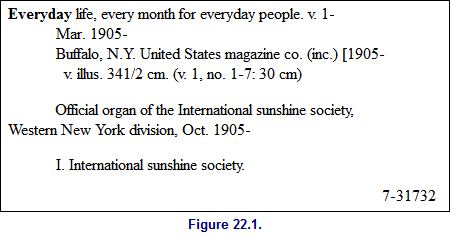
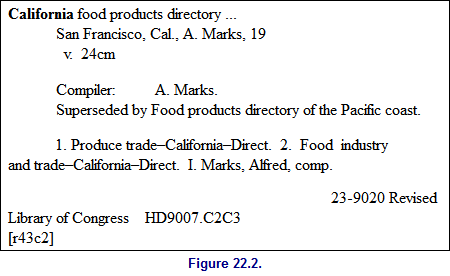
Choice of entry (ALA) -- Entry under corporate body
Many titles were entered under corporate body, including many government publications, proceedings of societies, annual reports, and minutes of conferences.
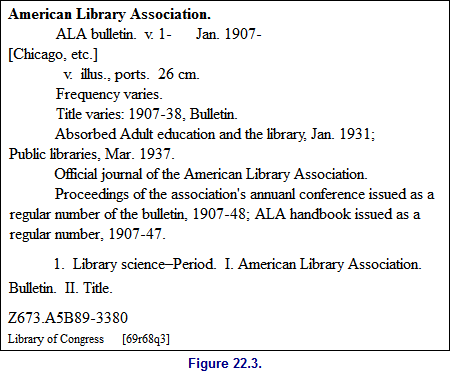
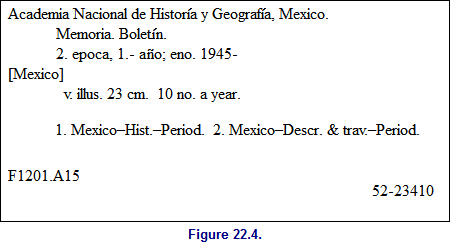
Choice of entry (AACR) -- Entry under title
Under AACR, periodicals, bibliographies, indexes, directories, biographical dictionaries, almanacs, and yearbooks were entered under title.
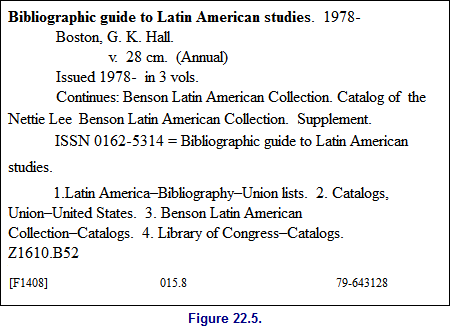
Choice of entry (AACR) -- Entry under personal name
Serials were entered under personal name when the name was preceded by the words "prepared by" or "by" on the title page. No statement of responsibility was recorded, however.
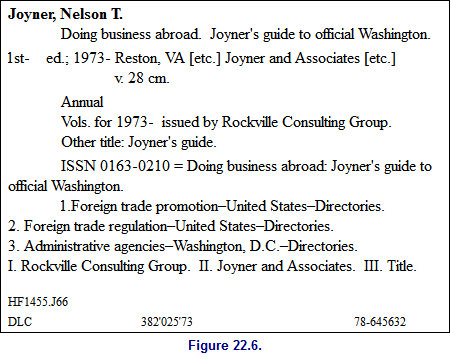
Choice of entry (AACR) -- Entry under corporate body
More serials, particularly statistical publications, were entered under body than is the practice with AACR2.
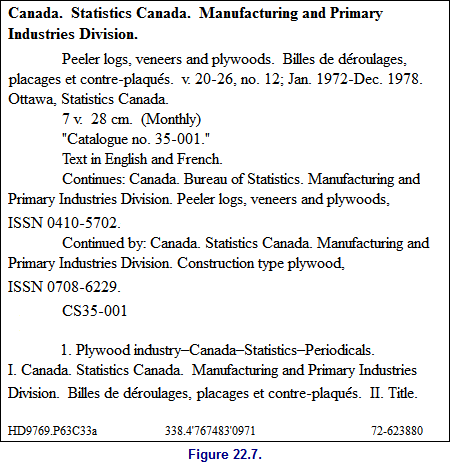
Changes in entry (ALA) -- Latest entry
Latest entry records are those in which the earlier titles and/or headings, for records entered under heading, are given on the same record in notes and as added entries.
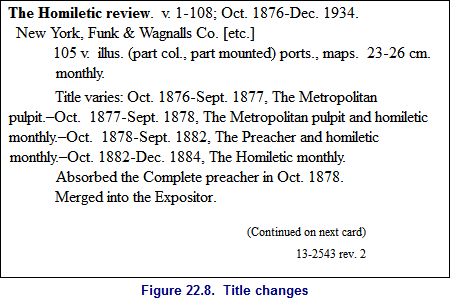
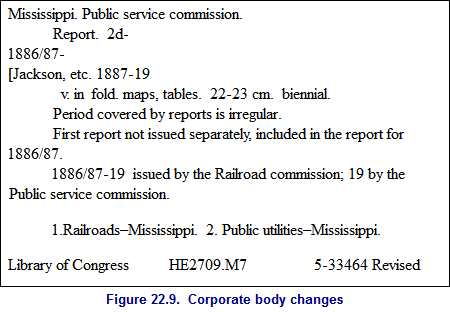
Changes in entry (ALA) -- Successive entry
Successive entry records are those for which a separate record is made each time the title and/or heading changes. Note that the links are based on the key title rather than the cataloging entry (see 22.4.9d.).
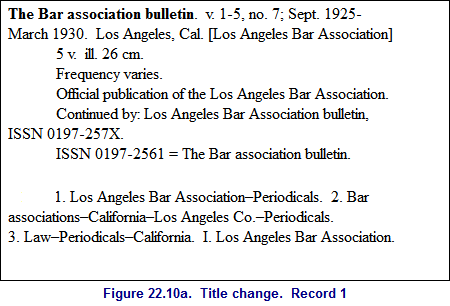
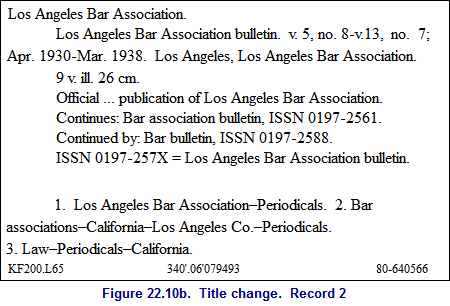
See also: